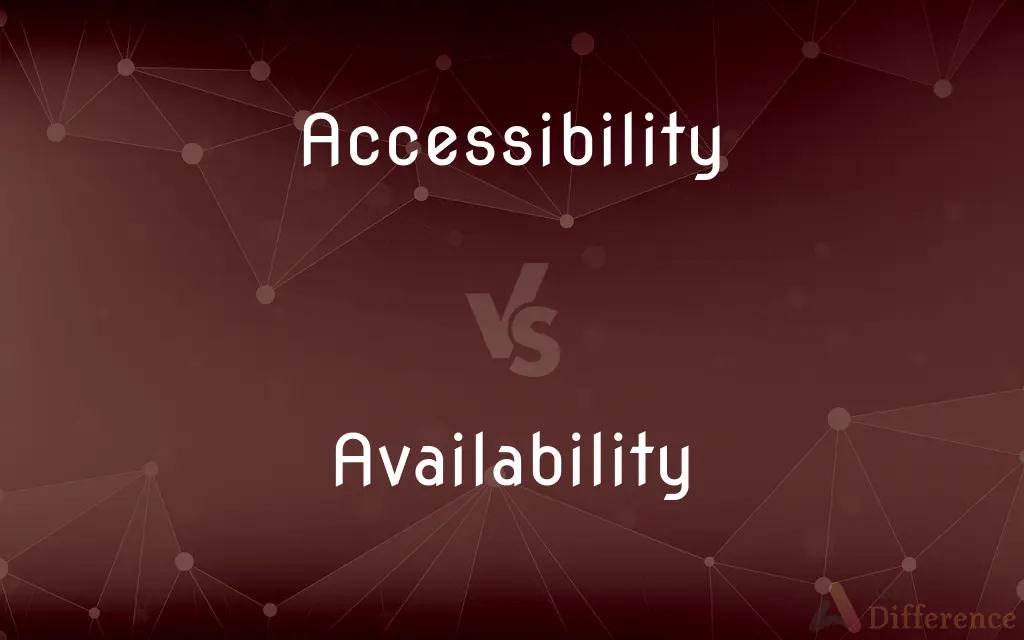Accessibility vs. Availability — What's the Difference?
Edited by Tayyaba Rehman — By Urooj Arif — Updated on March 7, 2024
Accessibility refers to the ease with which something can be reached or used by people, often emphasizing inclusivity, while availability denotes the presence or readiness of something for use, focusing on its presence or readiness.

Difference Between Accessibility and Availability
Table of Contents
ADVERTISEMENT
Key Differences
Accessibility is concerned with the design and provision of services, spaces, and information in a way that allows everyone, including those with disabilities, to use them fully and independently. It emphasizes removing barriers that might prevent people from utilizing a service or accessing information. This can include physical barriers, such as lack of wheelchair ramps, as well as digital barriers, like websites that are not compatible with screen readers. On the other hand, availability refers to whether something is on hand or obtainable. It denotes the state of being present or ready for use but does not inherently consider the user's ability to access or utilize it.
Accessibility is a key consideration in creating inclusive environments and services. It involves understanding and addressing the needs of all potential users, including those with physical, sensory, cognitive, or technological limitations. For example, in the digital realm, making a website accessible might involve ensuring it can be navigated using a keyboard only, or that text is readable by screen readers for the visually impaired. Whereas, ensuring the availability of a website simply means that the site is online and can be accessed by anyone with an internet connection, without necessarily considering the diverse needs of all users.
The concept of availability is crucial across various domains, including technology (e.g., server uptime), retail (product stock), and healthcare (access to medical treatment). It assesses the extent to which services or resources are at hand and can be utilized without necessarily accounting for individual user requirements. Accessibility, however, integrates the principles of universal design and inclusivity, aiming to ensure that services, tools, and environments are usable by everyone to the greatest extent possible.
Both accessibility and availability are essential for ensuring that resources, information, and services are effectively and equitably utilized. However, their focus differs significantly: accessibility is user-centered, considering the diverse needs of individuals, while availability is resource-centered, emphasizing the readiness or presence of services or goods.
Comparison Chart
Definition
The ease with which something can be used or accessed by everyone, including those with disabilities.
The state of being at hand or ready for use.
ADVERTISEMENT
Focus
Removing barriers for inclusive use.
Presence or readiness of something.
Key Considerations
Physical, sensory, cognitive, and technological barriers.
Resource presence, stock levels, service uptime.
Examples
Wheelchair ramps, braille signage, screen reader-friendly websites.
24/7 customer service, in-stock products, accessible servers.
Importance in
Creating inclusive environments and services.
Ensuring resources or services are obtainable.
Compare with Definitions
Accessibility
Implementing features in products that allow use by individuals with different abilities.
Voice-activated devices improve accessibility for individuals with physical impairments.
Availability
Stock levels sufficient to meet consumer demand.
Retailers monitor product availability to avoid stockouts during peak shopping seasons.
Accessibility
The degree to which a product or environment is usable by as many people as possible.
Installing elevators in buildings improves accessibility for those with mobility issues.
Availability
The readiness of a system or service to be used at any given time.
High server availability ensures websites remain accessible online.
Accessibility
Ensuring physical spaces can be entered and used by people with various disabilities.
Accessible restrooms are designed to accommodate wheelchair users.
Availability
Ensuring resources are on hand when needed.
Emergency services' availability 24/7 saves lives.
Accessibility
Making information understandable and consumable by diverse audiences.
Providing subtitles on videos enhances accessibility for the deaf and hard of hearing.
Availability
The ability to access or consult with a professional or expert.
The availability of doctors for telehealth consultations has increased access to medical advice.
Accessibility
Designing digital content to be navigable and usable for people with disabilities.
Accessible websites use alt text for images to aid visually impaired users.
Availability
The presence of a product or service for purchase or use.
The availability of flu vaccines is critical during winter months.
Accessibility
Accessibility in the sense considered here refers to the design of products, devices, services, or environments so as to be usable by people with disabilities. The concept of accessible design and practice of accessible development ensures both "direct access" (i.e.
Availability
In reliability engineering, the term availability has the following meanings: The degree to which a system, subsystem or equipment is in a specified operable and committable state at the start of a mission, when the mission is called for at an unknown, i.e. a random, time.
Accessibility
The quality of being able to be reached or entered
The restoration project involved repairing the roof and improving accessibility
Availability
The quality of being able to be used or obtained
Turkey producers had been losing sales because of the all-year-round availability of beef
The availability of social housing varies widely in rural areas
Accessibility
Easily approached or entered
The stadium is accessible via public transportation.
Availability
Present and ready for use; at hand; accessible
Kept a fire extinguisher available at all times.
Accessibility
Easily obtained
Accessible money.
Availability
Capable of being gotten; obtainable
A bedspread available in three colors.
Accessibility
Easy to talk to or get along with
An accessible manager.
Availability
Qualified and willing to serve or assist
A list of available candidates.
Was not available for comment.
Accessibility
Easy to understand or appreciate
An accessible artwork.
Availability
(Chemistry) Capable of being used in a chemical reaction
Available electrons.
Accessibility
Designed for use by anyone regardless of physical ability
Remodeled the restroom to make it accessible.
Availability
(Botany) Present, as in soil, and capable of being used by plants as a nutrient
Available water.
Available minerals.
Accessibility
Easily swayed or influenced
Accessible to flattery.
Availability
The quality of being available.
What is your availability this week?
Accessibility
The quality of being accessible, or of admitting approach; receptiveness.
Availability
(countable) That which is available.
We have several availabilities.
Accessibility
Features that increase software usability for users with certain impairments.
Availability
The quality of being available; availableness.
He was . . . nominated for his availability.
Accessibility
The quality of being accessible, or of admitting approach; receptibility.
Availability
That which is available.
Accessibility
The quality of being at hand when needed
Availability
The quality of being at hand when needed
Accessibility
The attribute of being easy to meet or deal with
Common Curiosities
How can organizations improve availability?
Organizations can improve availability by optimizing resource allocation, enhancing infrastructure, and implementing reliable systems and processes.
How does availability impact service quality?
Availability directly impacts the quality and reliability of services, affecting user satisfaction and trust.
Can improving accessibility also enhance availability?
Improving accessibility often enhances availability by making services and resources usable and beneficial to a broader audience.
What role does design play in accessibility?
Design plays a critical role in accessibility by determining how easily and effectively diverse users can interact with products and environments.
Why is accessibility important?
Accessibility is crucial for inclusivity, allowing individuals of all abilities to use, interact with, and benefit from resources and environments.
How does technology impact accessibility and availability?
Technology plays a pivotal role in enhancing both by enabling innovative solutions for access and ensuring resources are readily obtainable.
What challenges exist in balancing availability with accessibility?
Challenges include the cost of implementation, the need for ongoing maintenance and updates, and ensuring that efforts meet the diverse needs of all potential users.
How do availability and accessibility affect consumer choice?
Both factors significantly influence consumer choice, with availability ensuring that options are present and accessibility ensuring all users can utilize them.
Can something be available but not accessible?
Yes, a resource can be available (present or ready for use) but not accessible if barriers prevent certain users from utilizing it effectively.
What is universal design?
Universal design is the practice of designing products, environments, and services to be usable by the widest range of people, focusing on simplicity and inclusivity.
How do businesses benefit from ensuring both availability and accessibility?
Businesses benefit by expanding their market, enhancing customer satisfaction, and potentially complying with legal requirements, leading to a positive brand image.
Is digital accessibility legally required?
In many jurisdictions, digital accessibility is legally required for public services and businesses to ensure equal access for individuals with disabilities.
What is the relationship between accessibility and equality?
Accessibility promotes equality by ensuring that everyone, regardless of ability, has equal access to information, services, and environments.
Are there standards for accessibility?
Yes, there are various standards for accessibility, such as the Web Content Accessibility Guidelines (WCAG) for digital content.
How can individuals contribute to promoting accessibility?
Individuals can contribute by advocating for inclusive practices, providing feedback to organizations about accessibility issues, and supporting accessible products and services.
Share Your Discovery

Previous Comparison
Carton vs. Cardboard
Next Comparison
Opening vs. HoleAuthor Spotlight
Written by
Urooj ArifUrooj is a skilled content writer at Ask Difference, known for her exceptional ability to simplify complex topics into engaging and informative content. With a passion for research and a flair for clear, concise writing, she consistently delivers articles that resonate with our diverse audience.
Edited by
Tayyaba RehmanTayyaba Rehman is a distinguished writer, currently serving as a primary contributor to askdifference.com. As a researcher in semantics and etymology, Tayyaba's passion for the complexity of languages and their distinctions has found a perfect home on the platform. Tayyaba delves into the intricacies of language, distinguishing between commonly confused words and phrases, thereby providing clarity for readers worldwide.
















































